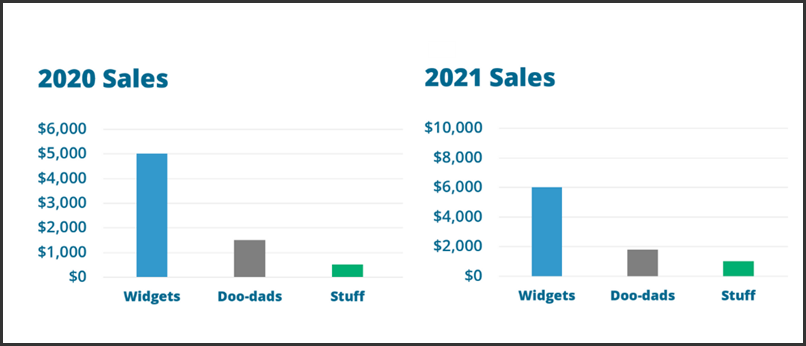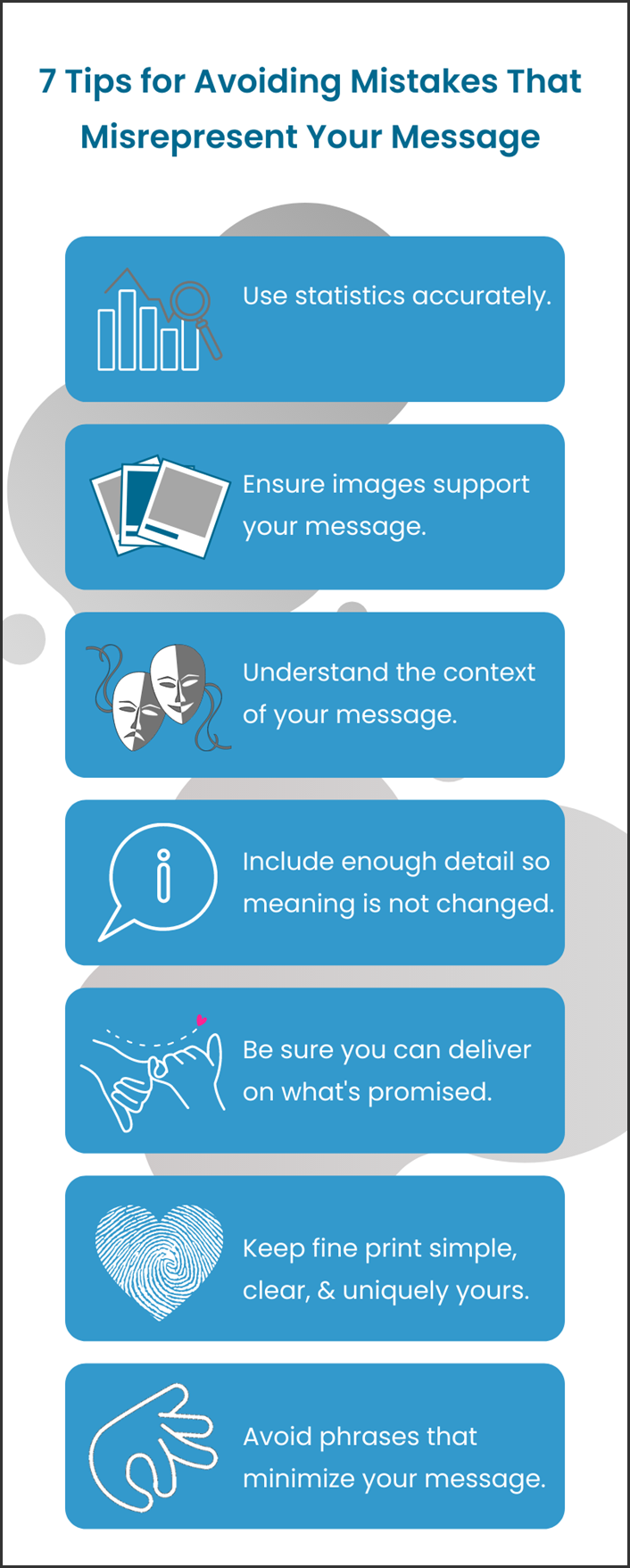 Do you feel some ads really misrepresent the facts? The whoppers are easy to spot.
Do you feel some ads really misrepresent the facts? The whoppers are easy to spot.
- Those claims to make you a millionaire with a simple click on a link.
- Or all the other “too good to be true” advertisements
- Thankfully, most of us are not in the business of scamming people.
However, there are inadvertent mistakes in business communication that can misrepresent your message.
Mistakes That Misrepresent Messages
The following 7 mistakes in your business communication may send an unintended message.
These exclude the darker side of misrepresentation – fraud and other intentional, illegal acts. We will leave that topic to law enforcement.
1. Twisted Statistics
Few mistakes destroy credibility faster than business communication that twist statistics into an unrecognizable form. Unfortunately, statistics that misrepresent the message infest the internet.
- Some are simple to identify.
- Statistics may be blatant lies or a distortion of the truth.
- Think COVID or politics.
The Pollyanna side of me believes many are unintentional. Our propensity for scanning has us skipping right over much-needed details. We need to slow down and think.
Uncovering the source of statistical information is like a walk through a harvest corn maze. We meander through unsourced data or information that is downright wrong.
Do your part to stop perpetuating bad statistics.
- Verify the source of the statistics.
- Review the source for interpretation.
- If you cannot locate the source, do not publish.
Do you really want inaccurate statistics representing your business communication?
2. Skewed Visuals
Images help business communication sizzle. They are powerful, tap into our emotions – but they can also misrepresent our message.
Misplaced images
Picture an interview with a well-known fitness expert. A pack of cigarettes sits on the coffee table in front of her. Even if the cigarettes are not hers, is that the message a fitness expert wants delivered?
Imbalanced scales
Graphics are an effective method for depicting statistics. But the chart or graph you use to illustrate statistics could misrepresent the message. It is the image version of twisted statistics.
For example, look at the two charts below.
If you glance at the images, it appears 2021 was not as good a year in sales as 2020. Something that stands out during a global pandemic.
However, check out the scales on both charts that contribute to the misrepresented message.
- The maximum point in the 2020 scale was $6,000 and $10,000 for 2021.
- Sales were actually better in 2021.
- However, due to the scale, 2021 results appear smaller than 2020 results.
As my dad always said – everything’s relative.
3. Context Confusion
Isn’t it interesting how often we dismiss a person’s claim that a quote was taken out of context?
We declare the person guilty and assume the response is a lame attempt at justifying his or her actions. Yet, how frequently have you “rushed to judgment” only to discover there really was another side to the story?
Political campaigns are experts in quoting out of context.
Or we get only surface facts and make damning judgments against an individual. Do you remember Richard Jewell, the security guard from the 1996 Olympics in Atlanta, Georgia?
- He discovered a bomb at Atlanta’s Olympic Park.
- At first, people declared him a hero.
- Then he became the FBI’s number one suspect.
For nearly three months, Richard Jewell suffered from a public assassination of his character. Only to have the FBI decide he was not the bomber. Years later, another man confessed.
Technology fakers
As great as technology is, it also makes it easier to misrepresent images and stories. And now deepfake technology puts words in the mouth of video participants that were never said.
And we wonder why people have a tough time trusting media.
Context confusion is another victim of scanning. By skipping over the details, we may misrepresent what we take out of context.
Don't fall victim to business communication that misrepresents facts by ignoring context. Click To Tweet4. Sin of Omission
I like to think most of us are reasonable people. That could be Pollyanna speaking again.
We make decisions by learning the details – even the not so favorable details. Omit some of the more critical details in your business communication and you do a disservice to your customers.
It reminds me of an experience I had while researching a gym membership. I bet you can relate.
- I asked for the cost of the membership.
- The gym representative danced around his clever sales pitch (which did not include the cost).
- I danced my way out the door, never to return.
5. False Promises
Business communication that offers false promises makes no sense to me. If there is no way you can deliver by Tuesday, why would you promise you could?
False promises drive a wedge between your sales and service teams. Not to mention your customers. Either eliminate those promises from the sales pitch or empower service to deliver on that promise. And make sure it happens.
So, before you send that business communication with all the promises attached to it, ask yourself:
Can you deliver on all you promised?
6. Fine Print Ditches
As consumers, we often ignore the obvious. We know the fine print contains bad stuff. But do we read it? Nope.
Fine print’s reputation is well earned. There is something sneaky about it. As an aging baby boomer with worsening eyesight, it may even be cruel.
If you must have fine print in your business communication, make it more obvious. I know that’s an oxymoron – fine print you can read.
Be a rebel. Make the fine print in your business communication simple, clear & unique.
Need some examples? Check out the fun the featured clothes manufacturers had with their fine print labels.
7. A Minimizing Effect
Besides false promises, twisted statistics, and an exaggeration or two, there is also a danger in minimizing your message.
What do you think when you hear a customer service representative say the following?
“Yes, we can do that, BUT…”
BUT – the most hated sound in business communication.
Cousins to the dreaded BUT include:
- I may be wrong…
- Just a suggestion…
- What we can’t/won’t do… or any other negative statement
Convert your business communication into positive language.
- Instead of – Yes, we can do that, but not until next week – substitute– Yes, we can deliver that next week
- Negative – I may be wrong – positive – I expect
- Instead of – Just a suggestion – substitute – We recommend
Well Represented
The message in your business communication should be clear. Beware of communication pitfalls that misrepresent your message.
Share your favorite tips in Comments for eliminating the misrepresentation of your business communication’s message.
==================================
Note: In 2015, SSB took a year-long alphabetic journey for better business communication. Each post contained an A-to-Z topic for creating better business communication. This ‘M’ post originally published on July 6, 2015, and this May 18, 2022, version updates it. The plan is to update each alphabetic post. Hopefully, it will not take a year to complete. 😊
===================================



Cathy, come to think of it, why doesn’t any business need T&Cs so complicated we won’t read them? I know I skip over them all the time. Not only is the type too small for me now, I find the writing turgid and difficult to understand. I can’t do anything about it so I skip it entirely.
You and a lot of us, Anne. I sure cannot come up with a reason that they can’t be easy to read. But then I have a simple mind. 😉 Thanks, Anne, for sharing your thoughts.
Loved the graph- it’s the most common situation among techies.
Thanks, Roy. Appreciate it. 🙂